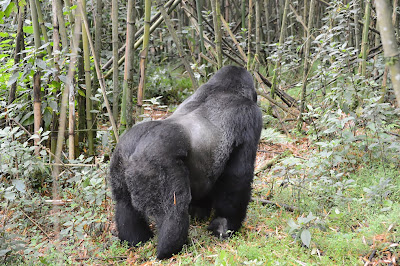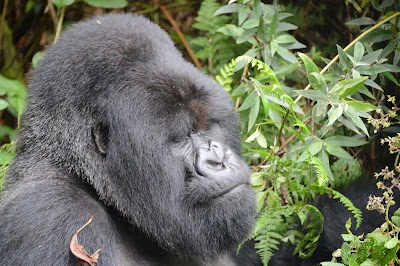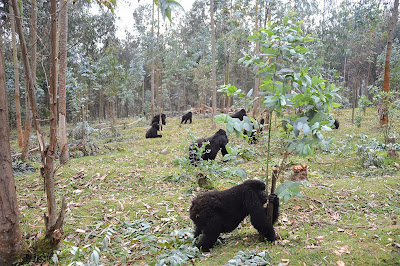GORILLA DAY
26/9/13
This was the day. The one we'd been waiting for. We saw the gorillas.
We left the Lodge at 6.30 after breakfast
and Herbert drove us to the Park Headquarters to process our gorilla permits. They provided some nice Rwandan coffee to kick start the process.
There are 10 groups of gorillas in the area
that tourists visit daily. Another 4 groups are used for research. The gorillas
are endangered but due to care and an awareness by the Rwandan people of their
importance for tourism their numbers have increased by 20% in the last 10
years. Eighty tourists are allowed to visit daily – 8 to each group.
Trackers follow the gorilla groups from a
distance during the day until they settle for the evening to sleep. They take a
GPS reading of where the groups are. Early in the morning other trackers go to
where the groups were the night before and radio headquarters as to current position so that the tourist visits can be planned.
Tourist groups are selected for gorilla
groups based on fitness and age. Some gorilla groups may be quite high up and
if they walk away from you the walking can be long and challenging. There are
no guarantees. The bush can be quite prickly to walk through and long trousers,
long sleeve tops and light gloves are recommended.
Herbert used to be a gorilla guide and
knows a lot of the staff at Headquarters. He was committed to giving us a good
viewing and not too much walking. The rainy season was just starting and it looked a
little ominous. Herbert reassured us that he’d been to the traditional healing
doctor (read witch doctor I think) in the village the night before after he’d dropped us off and asked him
not to let it rain until we’d seen the gorillas. It didn’t always work but
mostly it did. Who were we to argue!
We got allocated to the Hirwa or Lucky
group. We were shown pictures of them and told about their history. Silverback
males are over 10 years old. There is a dominant silverback in every group.
Other silverbacks are allowed in the group but not allowed to mate with the
females or challenge the lead male. If they do they either have to fight the
dominant male and win or go off and develop their own groups, if they can
convince females to go with them.
The dominant male in Hirwa was the third
male in another group in 2004. He left and persuaded 3 females from other
groups to join him and now has a group of 15 including 2 ½ year old twins which
is unusual for gorillas.
After our permits were processed Herbert drove us over a very rough track
for 25 minutes to where we would start to walk to our group. We were told that
they weren’t too far away.
So we set off with a cast of many. Two
guides and about four armed guards who we were told would fire a shot if
necessary to warn off buffalos who are encountered occasionally in the forest and can be
aggressive.
Herbert had packed water and snacks, including lunch, for us to put in our day packs.
Porters are available to hire to carry your daypack and help you over difficult parts. You are encouraged to use them because they are people who may have been tempted to poach in the past and the idea is to let them benefit from preserving the gorillas. The only payment they get is from the tips they get from tourists. We complied willingly believing that it was a very smart way of preventing future poaching.
The trackers had also come down and about 10 of them joined the first part of the walk.
I had been a bit anxious about the intensity of the walking required. There are some frightening tales online of people finding it very arduous. Bob assured me that I had probably more bushwalking experience than most and wouldn't find it too hard. (As usual he was right!)
Herbert had packed water and snacks, including lunch, for us to put in our day packs.
Porters are available to hire to carry your daypack and help you over difficult parts. You are encouraged to use them because they are people who may have been tempted to poach in the past and the idea is to let them benefit from preserving the gorillas. The only payment they get is from the tips they get from tourists. We complied willingly believing that it was a very smart way of preventing future poaching.
The trackers had also come down and about 10 of them joined the first part of the walk.
I had been a bit anxious about the intensity of the walking required. There are some frightening tales online of people finding it very arduous. Bob assured me that I had probably more bushwalking experience than most and wouldn't find it too hard. (As usual he was right!)
We walked towards the forest for a few
minutes and then changed direction to go across country for 500 meters or so.
My porter Michael didn’t speak any English but held my hand and led me when
there was the slightest undulation. It would have been almost impossible to
fall as we’d been given sticks to use as well and it was pretty much flat ground.
As we got near the forest wall we were given our final briefing and told the gorillas were very near. We climbed over a wall into the forest, walked a few meters and there they were – only 40 minutes after we’d left.
As we got near the forest wall we were given our final briefing and told the gorillas were very near. We climbed over a wall into the forest, walked a few meters and there they were – only 40 minutes after we’d left.
As it appears gorillas are usually calm and peace loving. The silver backs will occasionally fight to the death however. I overheard someone who had been to another group saying that they couldn't get too close because the silverbacks were a bit agitated.
Our group - Hirwa is known as one of the most peaceful because there is only one silverback and therefore no opposition to his authority.
The permits to see the gorillas cost $750 US each. A significant amount of money. We thought about it and then decided that as it was on our bucket list and we were close by we would do it. And it was so worthwhile.
It was encouraging to find when we got to Rwanda that it appears the permit money is being put to good use. Gorilla viewing is Rwanda's main tourist attraction and there is an awareness that they need tourism money for the country's economy.
One third of the permit money goes into the local community and the community has a say in how it is spent. It has been used to build new schools so that the local children do not have to walk so far to school.
There have been incidents in the past of buffalos and gorillas eating the locals crops and gorillas being seen as a threat to the villagers livelihood. Some of the permit money has been spent to build a large stone wall along the forest edge which is a deterrent to to the buffalos in particular.
We were told that the villagers are now much more tolerant of the gorillas, are generally proud of them and see their benefit to the community. Very smart marketing!
Permit money is also used to care for the gorillas and for research. Each gorilla is known and followed. Vets check them annually and are available to treat them if they are ill.
One of the threats to the gorillas is contracting human illnesses. We would not have been allowed to go to the gorillas if we had a cold or other infectious illness.
It was amazing. They just went about their
business of eating bamboo shoots and were unconcerned about us. The guides made
some grunting noises which the silverback responded to which apparently
indicated all was well.
I was so excited to see them it was hard to hold the camera still to take photos. We watched as they moved through the forest. They were very kind to us and moved parallel to the edge of the forest so although it was rough terrain there wasn’t much climbing involved. Tourist groups are allowed to stay for 1 hour exactly. You are supposed to keep 7 meters away from them and are not allowed to obstruct or touch them. If they come towards you that’s OK. The time went very quickly. It just felt so special to be so close to such beautiful animals.
Beautiful hand and close enough to zoom in on.
This mother has her 1 month old under her arm. We only got a very quick look and weren't able to photograph it.
The silverbacks coat really is silver.
I was so excited to see them it was hard to hold the camera still to take photos. We watched as they moved through the forest. They were very kind to us and moved parallel to the edge of the forest so although it was rough terrain there wasn’t much climbing involved. Tourist groups are allowed to stay for 1 hour exactly. You are supposed to keep 7 meters away from them and are not allowed to obstruct or touch them. If they come towards you that’s OK. The time went very quickly. It just felt so special to be so close to such beautiful animals.
Beautiful hand and close enough to zoom in on.
This mother has her 1 month old under her arm. We only got a very quick look and weren't able to photograph it.
This mum could do with a boob job!
The silverbacks coat really is silver.
Many times they came very close to us so I had
to keep reducing the zoom on my camera. During the last few minutes they left
the forest and went into the eucalyptus trees nearby where they started pulling
down branches and stripping and eating the bark and the leaves. It was much
easier to see them in the relative open. The twins climbed up trees and got the
leaves from the top.
This is the stone wall built as a deterrent to the animals going into the agriculture area. Not much use in this case but they didn't go into the cultivated area.
Silverback's bum!
This is the stone wall built as a deterrent to the animals going into the agriculture area. Not much use in this case but they didn't go into the cultivated area.
Silverback's bum!
The silverback climbed onto the stone wall and surveyed it before they moved out into the eucalyptus forest.
Eucalypts are Australian trees but have been introduced into Africa. The gorillas have certainly adapted to them. The trees do take a lot of water we're told so are not so good near crops.
No trouble to climb the tree when you're this little and light.
We were given a 2 minute warning that we
had to leave and would you believe right at the end of that it started to rain!
We walked back to our vehicles in light
rain but feeling exhilarated and oh so fortunate. The round trip, including
many stops and an hour with the gorillas, was 2 ½ hours. A cinch compared to what it could have been. We were the
first group back by a long way and when we left the Lodge after lunch at 2pm 4
groups were still out.
My guide - Michael. It was a pretty easy day at the office for him - and us! We were told that it is unusual for a group to be so close and even more unusual for them to go outside of the forest so we were lucky on both counts.
Herbert rang a friend the next morning and told us that it had rained heavily all morning that day which would have made trekking and seeing the gorillas more challenging.
We were presented with certificates as a memory. Given how easy the trek was it couldn't have been for doing it well!



























































1 comment:
8 years ago when passing through uganda to the Congo, iy was $US250, in Uganda. Inflation!
Post a Comment